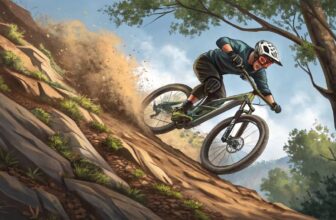The Art of Trail Manners
Smart mountain bikers know that playing nice on the trails keeps things safe and fun for everyone. Let’s chat about two biggies in trail manners: Giving Way Going Up and Being Cool on Bridges and Skinny Paths.
Giving Way Going Up
When you’re hitting mountain trails, always give the uphill folks their space. They’re working hard against gravity, and it’s tough for them to control their speed like the ones zooming down. So, give ’em a break and scoot to the side. If you’re riding an e-bike, remember it’s courteous to give way not just to uphill bikers but also to hikers and horse riders.
Being Cool on Bridges and Skinny Paths
Bridges and tight spots call for some cool moves. When you roll up to a narrow bridge or trail section, hit the brakes and let anyone already on it pass first. No matter if they’re climbing up or cruising down. This keeps crashing away and makes sure everyone gets through without a hitch.
By following these basic rules, we’re not just keeping it safe but making the trails pleasant for all. Want to amp up your biking know-how? Check our basic mountain biking skills section.
Sustainability on the Trails
Mountain biking sure leaves a footprint! But worry not, we can keep those lovely trails looking as pretty as ever. With just a bit of TLC, bikers can safeguard the woods for the little ones who’ll be shredding in 2075. Here’s your how-to guide for keeping it green and neat on the tracks.
Staying on Designated Paths
Imagine you’re in a forest maze. Stick to it. Straying from the marked routes isn’t just a bit naughty—it’s a real backyard burglar. It messes with Mother Nature and leaves poor critters confused and homeless. Best to follow the yellow, white, or any color trail signs (thanks, WORCA, we got you!). Forget shortcuts; thinkof long-term happiness for everything with leaves and fur.
Key Steps:
- Just say no to solo paths.
- Let the forest breathe—don’t carve extra lines.
- Closed signs mean no swerving in.
Trail Impact Mitigation
Lighten your tread, folks! As per the IMBA, keeping trails safe for the next rider means no splish-splashing around when the weather’s bad. Sharing the trail? Step aside politely without trashing the place. The real MVP? The ethos of Leave No Trace.
More stuff you can do:
- Keep the bike parked when it’s soggy out.
- Peddle through puddles—avoid giving the path a redesign.
- Stick to current tracks without freelancing new paths.
| Action | Trail Impact |
|---|---|
| Sticking to paths | Minimal bruising |
| Cutting corners | Like a bull in a china shop |
| Going straight through puddles | Minor |
| Circling puddles | Medium mess |
No one loves a trail hog, so play nice with animals and fellow wanderers. Plus, if your four-legged buddy tags along, keep that leash and those manners ready for action (Thanks, IMBA!).
Remember, green trails that last are the best gift for everyone! Check out our pages on playing nice with others on the trail here and keeping your bike tip-top here.
Sharing Trails Safely
Mountain biking isn’t just about the thrill; it’s also about keeping it cool on the trails. To make sure everyone’s having a great time and staying safe, here are some key pointers like letting faster folks zoom by and keeping it friendly on those downhill rides.
Yielding to Faster Riders
If you’re cruising along and hear those wheels humming behind you, it’s time to be a trail champ and let ’em fly by. Making way for speedsters keeps everyone happy and upright. According to WORCA, smooth letting go is key.
How to Yield Like a Pro:
- Scoot over when you can safely and let the speed demons pass.
- Give a wave or shout to show you’re ready to play nice.
- Stay steady while you step aside or hold your ground.
For more cool tricks on mountain biking basic skills and slick-yielding moves, swing by our resource links.
Interacting on Downhill Tracks
Downhill runs are where you strike gold but also meet fellow riders, hikers, and even the occasional horse! Here’s the deal: bikers heading downhill should give a nod to those climbing up or moseying along, as IMBA suggests.
Downhill Etiquette 101:
- Ease up on the gas when others are near.
- Let them know you’re coming with a friendly greeting or ring-a-ding from your bell.
- Smile, wave, and take a breather if needed so walkers or ponies can go by safely.
Sticking to these pointers on downhill sections makes the ride safe and keeps smiles all around. Curious about stopping power? Check out our mountain bike brakes comparison article for more.
By sticking to these safety tips and spreading good vibes on the trails, everyone gets to enjoy the ride without any bumps in the road.
Essential Safety Measures
Mountain biking is like dancing with danger, only more epic. Sure, there’s a thrill factor, but playing it smart means you’ll ride another day. Ready to gear up on mental prep, the right gear, and not ticking off fellow trail folks? Right on.
Mental Preparedness
Mind games ain’t just for chess; they’re key on the biking scene too. Eyes peeled for sneaky rocks and roots that might as well laugh in your face. Know your limits. Trying to ride what’s meant for pros? That’s just rolling the dice on a first-name basis with broken bones. For the lowdown on ratcheting up those biking skills, hop over to our piece on mountain biking basic skills.
Carrying the Right Gear
Dressing up for success isn’t just for job interviews. Sporting the right gear can be your superhero outfit for the trails. Your head’s best pal? A trusty helmet. And don’t leave home without gloves and killer shoes. Indeed, a repair kit is like having duct tape in life—indispensable. Here’s your basic toolkit checklist:
- Multi-tool
- Tire levers
- Spare tube or patch kit
- Pump or CO2 inflator
For a deeper dive into gear must-haves, hit up our best mtb tool kit guide.
Hydration is key; nobody likes a dehydrated mess. Grab a hydration pack or some bottles. Love a little moonlight madness? Bring lights for night rides. Light up your life with our best mountain bike lights resource.
Trail Etiquette with Other Users
Being trail-wise saves lives—or at least makes friends. Play nice: let uphill riders do their thing and don’t buzz past hikers or horses like an uninvited pest. A “hello” keeps the peace and maybe earns you brownie points.
| Interaction | Etiquette |
|---|---|
| Uphill Cyclists | Yield, lest you become their unintentional workout |
| Faster Riders | Let ’em by and wave like you’re not bitter |
| Hikers and Equestrians | Slide on over and let them pass, no one likes a trail hog |
Think of the earth like your grandma’s dining room—don’t mess it up. Stick to the paths, keep Mother Nature smiling, and remember, no one likes a litterer.
Roll over to our other guides on mountain bike maintenance and how to clean mountain bike to become the biker everyone envies.
Follow these nifty tips, and you’ll ride like you own the trail—without the trail writing you back with a scolding. Keep it cool, and share those good vibes on every ride.
Emergency Readiness Tips
Planning a mountain bike trip? Don’t leave home without a plan for those curveballs Mother Nature might throw at you. Gear up with these down-to-earth tips to keep you safe when the unexpected kicks in.
Risk Assessment
Before you hit the pedals, take a moment to size up the situation. Scoping out your biking spot is like looking both ways before crossing the street, and it keeps you out of tight spots. Think about:
- Weather turning nasty
- If your phone signal’s sketchier than a spotty Wi-Fi connection
- Whether the path’s going to be smooth sailing or a rocky ride
- How easy it is for the cavalry to reach you if things hit the fan
Knowing what you’re getting into helps you steer clear of sticky situations. Stick to what you’re comfy with, especially if you’re riding solo, and ease off the risky stunts. If you’re just starting out and want to up your game, peek at our mountain biking basic skills.
Emergency Contact Preparedness
It’s all about having a solid game plan if the roses hit the fan. Here’s how to stay connected when the chips are down:
- Keep that phone juiced up and loaded with a map app
- Memorize those local SOS digits
- Let someone know your adventure outline
- Carry your ID along with any need-to-know medical deets
That little piece of plastic with your info could be your hero during a pickle. Clueing someone in on your plans makes sure there’s a backup in case things go haywire.
Safety While Riding Alone
Flying solo on the trails cranks up the stakes, but a few tricks can keep you on the right track:
- Tap a buddy or fam to follow your route
- Dodge paths where signals vanish into thin air
- Stash the knick-knacks: tools, water, munchies, and a trusty map
Here’s a cheat sheet for solo rides:
| Gear | Purpose |
|---|---|
| Charged-Up Phone | Reaching Out |
| Handy Tool & Repair Kit | Quick Fixes |
| Water & Snacks | Stay Fresh & Fueled |
| Map or GPS | Stay Oriented |
Hungry for more? Check out our mountain biking essentials and mountain bike maintenance guides.
Being all set before you roll out makes your ride happier and safer. To dig into more cool biking hacks, take a gander at mountain bike pedal types and mtb suspension setup. Keep the pedals turning and keep it real!
First-Aid Awareness
Dealing with Injuries
Anyone loving the rough-and-tumble nature of mountain biking knows it’s only a matter of time before they take a tumble. But when spills get serious, knowing how to deal with them becomes a game-changer. Surveys show that 7 out of 10 bikers have had gnarly crashes at least once.
Simple Steps to Handle Common Injuries:
- Keep Your Cool: Losing it won’t help anyone. Stay level-headed to properly check the injured person.
- Patch Up Minor Cuts: Give small cuts and scrapes a rinse with water and a bit of soap. Smear on some germ-fighting cream and slap on a bandage.
- Bruises and Bumps: An ice pack or a bag of frozen peas works wonders to keep swelling down. Rest the limb up high if you can swing it.
- Dealing with Fractures: Keep the messed-up part steady with whatever’s handy. Steer clear of moving them if you suspect neck or spinal drama.
- Head Hits: Watch for signs of a concussion like feeling woozy or getting the spins. Get a doctor involved pronto if symptoms show up.
For those itching for more blow-by-blow instructions on dealing with bike biffs, take a gander at our mountain biking injuries guide.
Managing Emergency Situations
When chaos strikes, it’s about keeping your head straight, making sure the scene’s sorted, prioritizing what needs doing, and hollering to the pros for backup. Handling the chaos with a plan increases the chance of a smooth rescue.
| Action Steps | What’s It About |
|---|---|
| Make the Scene Safe | Double-check that the area around the injured isn’t a danger zone. |
| Take Stock | Measure the important stuff like how conscious they are, if they’re breathing, and pulse. Throw in CPR if required. |
| Call in the Calvary | Dial up the experts quick. Pass on the location and the lowdown on injuries. |
| Bandage Up | Grab the first-aid goodies to sort out bleeding, get fractures sorted, and snap them out of shock. |
| Stick Around | Be the company they need till the pros show up. Chatting can do wonders to chill them out. |
Preparing for Emergencies
- Scope Out Risks: Before you saddle up, weigh the risks. Highlight potential hiccups and map out safe paths.
- Communication Plan: Let somebody know your biking plans and expected return. Set a timer for when they should call the cavalry if you go AWOL.
- Solo Ride Smarts: Pack a fully-charged mobile, GPS gizmo, and emergency call list. A med ID bracelet can be a lifesaver, clueing in first responders on your health needs.
Sticking to these mountain biking safety pointers while being first-aid savvy amps up your trail-time fun. For the lowdown on must-have bike safety gear, check our article on mountain biking essentials. Enjoy riding like a pro!
Keeping Your Bike in Shape
If you’re cruising the trails on your mountain bike, keeping it in tip-top shape isn’t just an option—it’s essential for staying safe. Let’s dive into the nitty-gritty of how to keep your wheels ready to roll, starting with a pre-ride check and then getting into the nuts and bolts of ongoing care.
Pre-Ride Peek-A-Boo
Before you hit the dirt, a quick once-over can save you from a heap of trouble. Here’s your go-to checklist:
- Tire Pressure: Pump those bad boys to the recommended level. You can geek out over the details in our article on mtb tire pressure.
- Brakes: Make sure the brakes won’t fail you in the crucial moment. For more comparisons, check out our piece on mountain bike brakes comparison.
- Chain and Drive Train: Look for kinks and slap on some lube if things are looking dry. Hit up our mtb chain maintenance guide if you need the full scoop.
- Bolts and Fittings: Give everything a good twist to the settings in your owner’s manual (REI).
- Suspension: Make sure your suspension isn’t all wonky. Check out our article on mtb suspension setup.
A simple pre-ride check can be done with a trusty multi-tool. Want a deep dive? Check our full guide on mountain bike maintenance.
Keeping it Smooth
Regular upkeep is the secret sauce to making your mountain bike last longer than your last relationship. Here’s how to keep things running smoothly:
- Bathe Your Ride: Rinse off the grime after those muddy escapades. A garden hose works wonders, just keep it gentle and avoid blasting your bearings with water pressure.
- Chain Love: Keep the chain happy with high-quality lube, but don’t drown it. No one likes a greasy mess underneath them. Wipe away extra before your next ride. For an all-encompassing how-to, see our piece on how to clean a mountain bike.
- Brake Tune-Up: Make sure those pads hit the right spot on rims or rotors. For a step-by-step, check out the directions to bleed mtb brakes.
- Tire Check-Up: Keep an eye out for suspicious wear or damage. Swap them out if needed, and remember to keep ‘em inflated with our MTB tire pressure guide.
- Bolt Patrol: Routinely tighten bolts as per your manufacturer’s specs to keep things from shaking loose. A torque wrench can be your best friend here.
- Pro Help: Set up a date with your mechanic every now and then. They’ve got the eagle eyes for spotting hidden issues that you might miss.
| Task | How Often |
|---|---|
| Scrub-a-Dub-Dub | After each ride |
| Chain Lube Up | Every 1-2 weeks |
| Tire Look-Over | Before each journey |
| Brake Check | Monthly |
| Bolt Tightening | Monthly |
| Pro Check-Up | Every six months |
Stay on top of your mountain bike’s performance to ensure smooth and secure adventures. For more tips, and tricks, or to give your maintenance know-how a boost, check out diy mountain bike repairs and the best mtb tool kit. Keep that bike rolling, reduce your risks, and step up your riding fun!
Gear Essentials for Safety
Feeling safe on those crunchy bike trails starts with picking the right gear, letting you hit the ground running—or rolling—without a hitch. Let’s break down some stuff you should keep handy, both for yourself and your ride.
Protective Cycling Gear
Nobody wants to face-plant into a rock! These gadgets and gizmos cut down on spills and bring peace of mind.
1. Helmet
- Think of your helmet as a life saver. The Troy Lee Designs A1 MIPS Classic Helmet ain’t just a pretty hat; it’s either your hard hat or your friend in need with rotation protection, a snazzy visor, and breathable vents. Yours for $145.
2. Sunglasses
- Want your eyes shielded while looking cool? The Smith Ruckus Sunglasses are just the ticket—fog-proof and grippy. They’ll set you back $199.
3. Shoes
- Fancy staying on your bike? Try the Five Ten Freerider Pro Shoes for top-notch grip and all-day comfort, balancing stiff and squishy like a pro. Cost? $150.
4. Pads and Protection
- Falling hurts, duh! Elbow, knee pads, and back protectors are the VIPs of injury prevention, even if you’re a pro shredder.
5. Hydration Pack
- Stay watered down with the Osprey Syncro and Sylva. Rain cover, helmet loop, and magnetic bites—plus a hefty 2.5-liter bladder. Yours for $120.
Tools and Equipment Checklist
Trouble pops up when you least expect it. Having the right gear handy makes trail hiccups feel like no biggie. Here’s what you should pack:
| Tool/Equipment | Purpose |
|---|---|
| Multi-tool | Swiss army knife for your bike |
| Tire levers | To take off tires |
| Mini-pump or CO2 inflator | Air things up from deflated to inflated |
| Spare tube/Tubeless repair kit | Patch flats like a pro |
| Chain tool | For when your chain binge-watches itself break |
| Derailleur hanger | Mends bent hangers like fixing a wobbly chair |
| First-aid kit | Patch you up when you kiss dirt |
| Hydration system | Don’t go parched! |
| Nutrition (bars, gels) | Prevents you from pedaling-powered yawns |
| Phone/GPS device | Stay on track or dial in an SOS call |
Pack these tools—avoid getting caught slack-footed by common hiccups while mountain biking. Need tips on tuning your ride? Find them in our guides on mountain bike maintenance and DIY mountain bike repairs.
Armed with the right gear and tools, you can savor the thrill of your ride while staying safe. Get the full list by visiting our mountain biking essentials.




